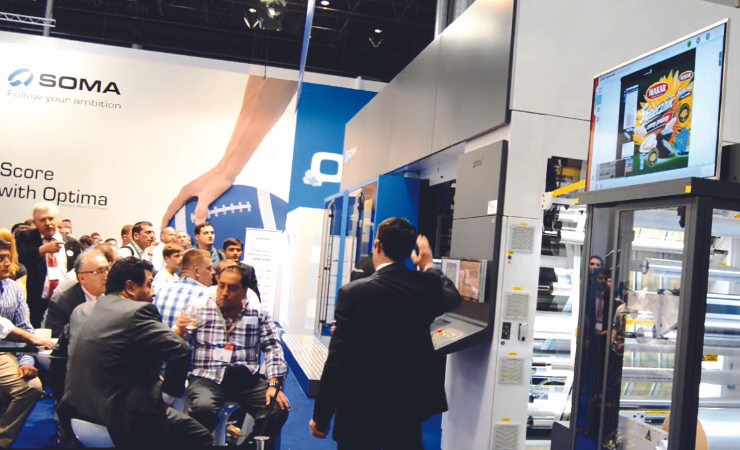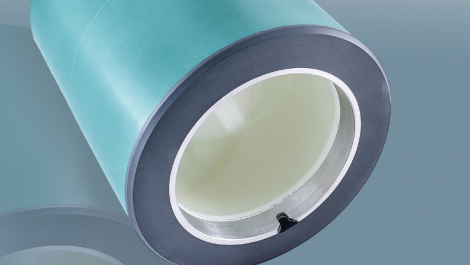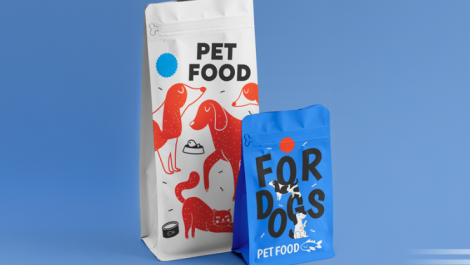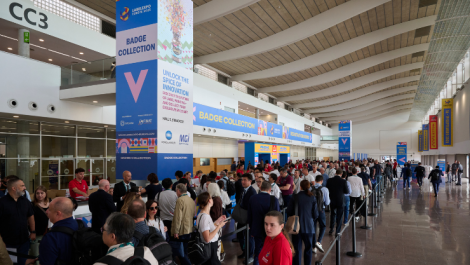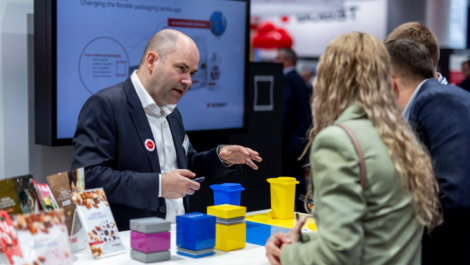Drupa 2024 is in the history books and will be remembered as a noteworthy milestone for those interested in flexo. Sean Smyth walked the halls in Düsseldorf and gives his perspective on what he saw.
While the headlines were grabbed by the latest generation of digital presses and software that are digitising print and packaging supply chains, this drupa was great for flexo. Lots of CI and narrow web flexo machines, even some sheetfed and corrugated flexo folder gluers as I wandered the aisles. Not all of these included flexo printing. Some manufacturers showed off their latest developments virtually, or invited prospects to nearby facilities to show off their new technology, while plate, anilox (and five anilox measuring equipment suppliers), CTP and prepress providers were out in force, along with ink makers eager to supply inks for the latest machines.
The show catalogue listed eighty flexo press manufacturers, about a quarter were from China, India or other Asian countries and the majority of these were new to me. Zhejiang Weigang Machinery Co certainly was. It makes narrow and medium web flexo presses, claiming an installed base of over 500 for its ZLR model. It is located in eastern China, some 300 miles from Shanghai, and it is keen to widen its installs into Europe and the Americas. It looked a well built label press, with fewer electronic controls and automation systems than in leading suppliers, but featuring laser die-cutting in-line.
Visiting some booths to obtain information proved to be difficult, with language barriers not letting me communicate effectively beyond being given literature – while some stands showed the backs of staff busy on their smartphones.
Unlike drupas of yesteryear, there were only a few examples of complete flexo presses actually producing work. Bobst, Koenig & Bauer and BW Converting displayed print samples and videos of their presses in action. Allstein, Comexi, KYMC, Soma, Uflex, Uteco and Xi’An Aerospace Huayang showed new models printing, along with W&H’s slick demos of its AlphaFlex showing the simple changeovers effectively. W&H also took visitors to its Lengerich site for more in-depth demos, including showing off its new inkjet capabilities. Soma had regular demos of its Optima press running at 400m per minute, showing the automatic plate loading and set up with a video screen displaying the quality from the high-definition camera. At the end of the demo it passed around print output and displayed customers buying the new press, sales finalised at the show.
Soma announced that it will supply Tresu with its fully automatic plate mounting system for Tresu unit presses. This will be an option for new presses and is available for retro-fitting onto existing press lines, helping users reduce make-ready time and waste. Tresu showcased the Flexo Innovator unit press with Dual Ink Deck that lets operators switch jobs during production, with minimum waste and more effective production time. It announced a sale to Zumbiel Packaging in the USA and shared that the agreement includes Tresu’s modular service concepts and spare part agreements to secure optimal OEE performance during the entire lifecycle of the press.
Heidelberg has a similar system. It displayed one unit from its Boardmaster press for cartons at the show. This promises zero make-ready and job changeover at 600m/min. The machine has two available printing units that are swapped at make-ready, using offline 3D plate scanning to set up the press automatically. When one is running, the next is made ready. Make-ready can include replacing the anilox, new plate sleeves and automatic colour wash up and change if needed.
Prepress innovations
In prepress, Esko unveiled the CDI Crystal XPS ‘Quartz Edition’, an innovation claimed to set new standards for flexo print quality, a genuine alternative to gravure. It features improved plate imaging with upgraded optics and optimised Crystal Screening software. There was a lot of activity at the plate vendors, DuPont, XSYS, Asahi, Fujifilm and Miraclon all highlighting sustainability benefits in their latest plates. Eco3 is a new entrant into the fray. It is the former Agfa plates business and is making a significant play into flexo under the Magis Eco brand of water wash plates. Miraclon was showing off its input into what it calls ‘Modern Flexo’, facilitating consistent, highly capable, efficient, sustainable printing. Its booth showcased a range of successful case studies that build on the strength of core Flexcel NX technology. Central were the aqueous Flexcel NX Ultra 42 processor for the Ultra Plate Technologies, using LED optimised plate technology that offers even cleaner printing for greater efficiency and sustainability benefits.
DuPont also majored on sustainability with the Cyrel FAST 1000 TD, thermal processing platemaking equipment for tags, label and medium web packaging for plate sizes up to 900 x 1200mm. The new design incorporates advanced features of fast processing, lower cost, and easier operator use, along with high quality print performance on a wide range of substrates and an overall lower environmental footprint. The Cyrel team showed a new flat top dot plate called Easy Fast EFM. It has medium hardness and an optimised formulation to print with excellent ink transfer on coated, uncoated, rough, and recycled papers while maintaining strong print performance on film.
XSYS introduced two new plates under the new nyloflex eco brand under the slogan ‘Lifting proven quality to a sustainable future.’ Florian Hoelzle, the nyloflex product manager, said, ‘This is to emphasize that increasing the product sustainability for us does not mean jeopardising the proven quality of the nyloflex brand. The highest print quality and product durability are imperative in order to maintain the competitiveness of our customers and the flexographic printing industry as a whole.’
Modern flexo
Label presses were in abundance at the show, and there were flexo folder gluers converting corrugated boards, along with robots steadily shifting and palletising stacks, reels and rolls. It was mesmerising to watch the AV Flexologic robots steadily applying tapes and plates to sleeves all day, without needing a break.
Modern flexo presses featured control systems and software automation that reduced the set up time and waste on press and also reducing the load on internal customer service personnel. This is the significant change as the flexo industry digitises and greatly increases productivity, losing the previous dependence on skilled flexo pressmen who are becoming rarer and more expensive. There were no actual flexo presses on Bobst’s stand, rather a group of models on a central round table and zones of interest, linked to demo machines at the company’s competence centres, showing how to use the latest machines more effectively.
Jean-Pascal Bobst was unapologetic, saying, ‘Our sustainable goals do not support moving and setting up heavy machinery at a show. We are highlighting the capabilities of Bobst Connect, as we help customers use their machinery more effectively. Bobst is changing, we are becoming a software company, not a heavy steel company. The future of packaging supply chains depends on sharing information to reduce time and avoid mistakes. Bobst will be at the forefront of this transformation, helping our customers meet their customers’ future needs.’
Drupa 2024 was a view of how flexo production will develop. Yes, there were lots of useful incremental improvements certainly available to purchase in plates, inks, presses and peripherals, but the real message from the show was that flexo is changing. Automation and connectivity are allowing the next generation of manufacturing companies employing flexo print to prosper.

